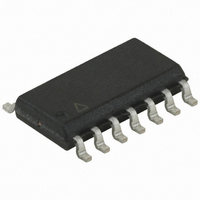ATTINY24-15SSZ Atmel, ATTINY24-15SSZ Datasheet - Page 13

ATTINY24-15SSZ
Manufacturer Part Number
ATTINY24-15SSZ
Description
MCU AVR 2K FLASH 15MHZ 14-SOIC
Manufacturer
Atmel
Series
AVR® ATtinyr
Datasheet
1.ATTINY24-15SSZ.pdf
(225 pages)
Specifications of ATTINY24-15SSZ
Package / Case
14-SOIC (3.9mm Width), 14-SOL
Voltage - Supply (vcc/vdd)
2.7 V ~ 5.5 V
Operating Temperature
-40°C ~ 125°C
Speed
16MHz
Number Of I /o
12
Eeprom Size
128 x 8
Core Processor
AVR
Program Memory Type
FLASH
Ram Size
128 x 8
Program Memory Size
2KB (2K x 8)
Data Converters
A/D 8x10b
Oscillator Type
Internal
Peripherals
Brown-out Detect/Reset, POR, PWM, WDT
Connectivity
USI
Core Size
8-Bit
Cpu Family
ATtiny
Device Core
AVR
Device Core Size
8b
Frequency (max)
16MHz
Interface Type
SPI/UART
Total Internal Ram Size
128Byte
# I/os (max)
12
Number Of Timers - General Purpose
2
Operating Supply Voltage (typ)
3.3/5V
Operating Supply Voltage (max)
5.5V
Operating Supply Voltage (min)
2.7V
On-chip Adc
8-chx10-bit
Instruction Set Architecture
RISC
Operating Temp Range
-40C to 125C
Operating Temperature Classification
Automotive
Mounting
Surface Mount
Pin Count
14
Package Type
SOIC
Lead Free Status / RoHS Status
Lead free / RoHS Compliant
Available stocks
Company
Part Number
Manufacturer
Quantity
Price
Company:
Part Number:
ATTINY24-15SSZ
Manufacturer:
ATMEL
Quantity:
349
Part Number:
ATTINY24-15SSZ
Manufacturer:
ATTINY
Quantity:
20 000
7701D–AVR–09/10
When an interrupt occurs, the global interrupt enable I-bit is cleared and all interrupts are dis-
abled. The user software can write a logical one to the I-bit to enable nested interrupts. All
enabled interrupts can then interrupt the current interrupt routine. The I-bit is automatically set
when a return from interrupt instruction, RETI, is executed.
There are basically two types of interrupts. The first type is triggered by an event that sets the
interrupt flag. For these interrupts, the program counter is vectored to the actual interrupt vec-
tor in order to execute the interrupt handling routine, and hardware clears the corresponding
interrupt flag. Interrupt flags can also be cleared by writing a logic one to the flag bit position(s)
to be cleared. If an interrupt condition occurs while the corresponding interrupt enable bit is
cleared, the interrupt flag will be set and remembered until the interrupt is enabled or the flag
is cleared by software. Similarly, if one or more interrupt conditions occur while the global inter-
rupt enable bit is cleared, the corresponding interrupt flag(s) will be set and remembered until
the global interrupt enable bit is set, and will then be executed by order of priority.
The second type of interrupt will trigger as long as the interrupt condition is present. These
interrupts do not necessarily have interrupt flags. If the interrupt condition disappears before
the interrupt is enabled, the interrupt will not be triggered.
When the Atmel® AVR® exits from an interrupt, it will always return to the main program and
execute one more instruction before any pending interrupt is served.
Note that the status register is not automatically stored when entering an interrupt routine, nor
restored when returning from an interrupt routine. This must be handled by software.
When using the CLI instruction to disable interrupts, the interrupts will be immediately dis-
abled. No interrupt will be executed after the CLI instruction, even if it occurs simultaneously
with the CLI instruction. The following example shows how this can be used to avoid interrupts
during the timed EEPROM write sequence.
Assembly Code Example
C Code Example
in r16, SREG
cli
sbi EECR, EEMPE
sbi EECR, EEPE
out SREG, r16
char cSREG;
cSREG = SREG; /* store SREG value */
/* disable interrupts during timed sequence */
_CLI();
EECR |= (1<<EEMPE); /* start EEPROM write */
EECR |= (1<<EEPE);
SREG = cSREG; /* restore SREG value (I-bit) */
; disable interrupts during timed sequence
; store SREG value
; start EEPROM write
; restore SREG value (I-bit)
Atmel ATtiny24/44/84 [Preliminary]
13


















